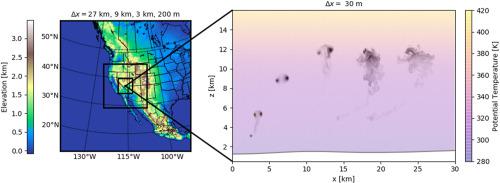Atmospheric Environment ( IF 4.2 ) Pub Date : 2021-04-01 , DOI: 10.1016/j.atmosenv.2021.118363 Robert S. Arthur , Katherine A. Lundquist , Jeffrey D. Mirocha , Stephanie Neuscamman , Yuliya Kanarska , John S. Nasstrom

|
Models of nuclear detonation cloud rise used by emergency planning and response teams are usually simplified to enable fast run times. They also contain parameters that are tuned to historical nuclear tests. Thus, they do not fully account for the complex environments that may be encountered in emergency scenarios. In this work, a multiscale framework, spanning numerical weather prediction to large-eddy simulation, is used to simulate nuclear cloud rise within the Weather Research and Forecasting (WRF) model. By employing this approach, cloud rise is modeled with higher fidelity, including time-varying three-dimensional weather fields and complexities such as atmospheric moisture and terrain. Using modified initialization routines that allow for the inclusion of a high-temperature fireball in WRF, cloud rise is first simulated for three U.S. nuclear tests over the Nevada desert. Grid nesting is used to dynamically downscale historical reanalysis data to a large-eddy simulation domain, where cloud rise is simulated at 20–30 m resolution. The downscaled atmospheric states agree reasonably well with observations from the time of the tests, and turbulent mixing induced by the cloud rise is captured. Simulated nuclear clouds show good overall agreement with available cloud rise observations, especially for high-air bursts with limited surface interaction. To demonstrate WRF's ability to capture aerosol-microphysics interactions during cloud rise, a semi-idealized large-eddy simulation of the wartime Nagasaki detonation is also performed. Self-induced rainout caused by the condensation of rising moist air during cloud rise is captured, and wet deposition of aerosol particles is quantified. Future work will better account for surface interactions, including particulate lofting and shockwave reflection, which should improve cloud rise predictions. Additional development of a multiscale simulation framework could permit seamless fireball-to-fallout simulations to study the relationship between cloud rise dynamics and fallout risk.
中文翻译:

使用“天气研究和预测”模型在现实的大气中模拟核云的上升
通常简化应急计划和响应小组使用的核爆云上升模型,以实现快速运行。它们还包含调整为历史核试验的参数。因此,它们不能完全解决紧急情况下可能遇到的复杂环境。在这项工作中,使用了一个多尺度框架,从数值天气预报到大涡流模拟,被用于在“天气研究与预测”(WRF)模型中模拟核云的上升。通过采用这种方法,可以以更高的保真度模拟云上升,包括时变的三维天气场和复杂性,例如大气湿度和地形。使用允许在WRF中包含高温火球的修改后的初始化例程,首先针对三个美国地区模拟了云上升 内华达沙漠的核试验。网格嵌套用于将历史再分析数据动态缩减至大涡流模拟域,在该域中以20–30 m的分辨率模拟云的上升。缩减的大气状态与测试时的观测结果相当吻合,并且捕获了由云层上升引起的湍流混合。模拟的核云与可用的云上升观测显示出良好的总体一致性,尤其是对于表面相互作用有限的高空爆发。为了证明WRF在云层上升过程中捕获气溶胶-微物理相互作用的能力,还对战时长崎爆炸进行了半理想化的大涡模拟。捕获了由于云层上升过程中上升的湿空气凝结而导致的自发降雨,并量化了气溶胶颗粒的湿沉降。未来的工作将更好地说明地表相互作用,包括粒子放空和冲击波反射,这将改善云层上升的预测。多尺度仿真框架的其他开发可以允许无缝的“火球到辐射”仿真来研究云层上升动力学与辐射风险之间的关系。











































 京公网安备 11010802027423号
京公网安备 11010802027423号